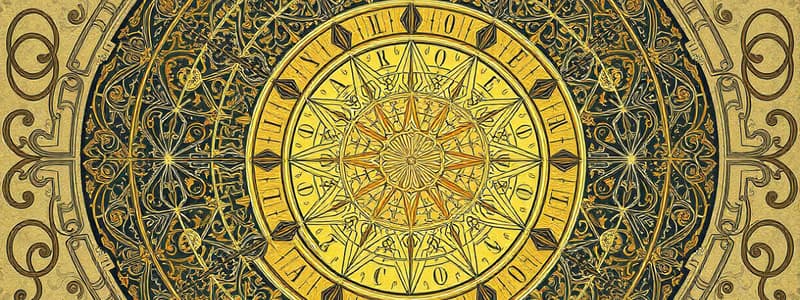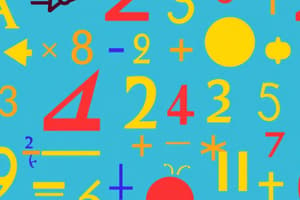Podcast
Questions and Answers
Arithmetic is the most recent branch of mathematics.
Arithmetic is the most recent branch of mathematics.
False (B)
Algebra uses symbols to represent mathematical relationships.
Algebra uses symbols to represent mathematical relationships.
True (A)
Geometry does not concern itself with the size of figures.
Geometry does not concern itself with the size of figures.
False (B)
Trigonometry is used to study relationships between angles and sides of triangles.
Trigonometry is used to study relationships between angles and sides of triangles.
Integral Calculus concerns itself with rates of change and slopes of curves.
Integral Calculus concerns itself with rates of change and slopes of curves.
Probability is the measure of how unlikely an event will occur.
Probability is the measure of how unlikely an event will occur.
Discrete mathematics studies continuous structures rather than discrete ones.
Discrete mathematics studies continuous structures rather than discrete ones.
Number theory includes the study of prime numbers.
Number theory includes the study of prime numbers.
Abstract algebra focuses on specific examples rather than abstract concepts.
Abstract algebra focuses on specific examples rather than abstract concepts.
Topology studies properties of spaces preserved under continuous deformations.
Topology studies properties of spaces preserved under continuous deformations.
Flashcards
What is Mathematics?
What is Mathematics?
The abstract science of number, quantity, and space, used as a pure science or applied to other disciplines.
What is Arithmetic?
What is Arithmetic?
The oldest and most elementary branch of mathematics; it involves basic operations on numbers.
What is Algebra?
What is Algebra?
A generalization of arithmetic that uses symbols to represent numbers and mathematical relationships.
What is Geometry?
What is Geometry?
Signup and view all the flashcards
What is Trigonometry?
What is Trigonometry?
Signup and view all the flashcards
What is Calculus?
What is Calculus?
Signup and view all the flashcards
What are Statistics and Probability?
What are Statistics and Probability?
Signup and view all the flashcards
What is Discrete Mathematics?
What is Discrete Mathematics?
Signup and view all the flashcards
What is Number Theory?
What is Number Theory?
Signup and view all the flashcards
What is Abstract Algebra?
What is Abstract Algebra?
Signup and view all the flashcards
Study Notes
- Mathematics is the abstract science of number, quantity, and space
- Mathematics may be used as a pure science, or applied to other disciplines
- Mathematical study usually involves seeking patterns and using them to formulate new conjectures
- Mathematicians resolve the truth or falsity of conjectures by mathematical proofs
Arithmetic
- Arithmetic is the oldest and most elementary branch of mathematics
- It deals with basic operations on numbers, including addition, subtraction, multiplication, and division
- More advanced operations include exponentiation, root extraction, and taking logarithms
- Arithmetic operations are performed according to a specific order of operations
Algebra
- Algebra is a generalization of arithmetic
- It uses symbols to represent numbers and mathematical relationships
- Algebra deals with solving for unknown variables in equations
- Key concepts include variables, expressions, equations, and inequalities
- Algebra is pivotal in solving real-world problems by creating and manipulating mathematical models
Geometry
- Geometry concerns itself with shape, size, relative position of figures, and the properties of space
- Plane geometry concerns 2D shapes that can be drawn on a flat surface like a piece of paper (e.g., squares, circles, triangles)
- Solid geometry concerns 3D shapes such as cubes, spheres, pyramids, and prisms
- Analytic geometry uses algebra to study geometry, defining geometrical shapes in a coordinate system
- Geometry provides tools to understand structures and spatial relationships mathematically
Trigonometry
- Trigonometry studies relationships between angles and sides of triangles
- Trigonometric functions are used to describe these relationships (sine, cosine, tangent, cotangent, secant, cosecant)
- Trigonometry is fundamental in fields like surveying, navigation, and physics
- It is used to calculate distances, angles, and heights that are otherwise difficult to measure directly
- Trigonometry also plays a role in modelling periodic phenomena, such as waves
Calculus
- Calculus studies continuous change
- Differential Calculus concerns itself with rates of change and slopes of curves
- Integral Calculus concerns itself with accumulation of quantities and the areas under/between curves
- Key concepts include limits, derivatives, and integrals
- It is used to model dynamic systems in physics, engineering, economics, and computer science
- Calculus provides tools for optimisation and understanding the behaviour of functions
Statistics and Probability
- Statistics involves collecting, analysing, interpreting, and presenting data
- Probability is the measure of the likelihood that an event will occur
- Key concepts include mean, median, mode, variance, standard deviation, and probability distributions
- Statistics is used in scientific research, business analytics, and social sciences
- Probability is essential in understanding risk, making predictions, and designing experiments
Discrete Mathematics
- Discrete mathematics studies mathematical structures that are fundamentally discrete rather than continuous
- It includes topics such as logic, set theory, graph theory, combinatorics, and number theory
- Logic provides rules for mathematical reasoning, while set theory is foundational
- Graph theory is used to model relationships between objects, and combinatorics revolves around counting
- Discrete mathematics bridges theoretical mathematics with computer science
Number Theory
- Number theory studies the properties and relationships of numbers, especially integers
- It includes topics such as prime numbers, divisibility, modular arithmetic, and Diophantine equations
- It has applications in cryptography and computer science
- Prime numbers and factoring are particularly important in securing data transmissions
- Number theory also includes the study of different types of numbers, such as rational and irrational numbers
Abstract Algebra
- Abstract algebra studies algebraic structures such as groups, rings, and fields
- It is a generalization of elementary algebra, focusing on abstract concepts and structures
- It provides a framework for understanding mathematical systems and their properties
- Abstract algebra is used in coding theory, cryptography, and theoretical physics
- Group theory, a central part of abstract algebra, is used in the study of symmetry
Topology
- Topology studies properties of spaces that are preserved under continuous deformations
- It deals with concepts such as connectedness, continuity, and boundaries
- Topology is used in data analysis, physics, and computer graphics
- It provides tools for studying the qualitative aspects of shapes and spaces
Mathematical Proofs
- Mathematical proofs are logical arguments that establish the truth of a statement
- Proofs are based on axioms, definitions, and previously proven theorems
- Common proof techniques include direct proof, proof by contradiction, and proof by induction
- Rigorous proofs are essential to ensure the correctness of mathematical results
- Counterexamples are used to disprove conjectures
Mathematical Modelling
- Mathematical modelling is the process of creating mathematical representations of real-world phenomena
- Models can be used to make predictions, analyse systems, and optimise processes
- Mathematical modelling integrates various mathematical techniques
- Models must be validated to determine their accuracy and reliability
- Models are revised as new data become available
Importance of Mathematical Notation
- Mathematical notation is a system of symbolic representations
- It allows mathematicians to express complex ideas concisely and unambiguously
- Standard symbols are used for operations, variables, and mathematical objects
- Proper use of notation is essential for clear communication in mathematics
- Notation evolves over time as new concepts and methods are developed
Problem Solving
- Problem solving is a fundamental skill in mathematics
- It involves understanding the problem, developing a plan, executing the plan, and reviewing the solution
- Problem-solving strategies include working backwards, finding patterns, and breaking problems into smaller parts
- Persistence and a willingness to try different approaches are important
- Effective problem solving enhances mathematical understanding and builds confidence
Studying That Suits You
Use AI to generate personalized quizzes and flashcards to suit your learning preferences.




